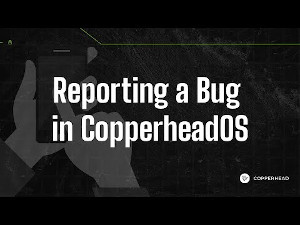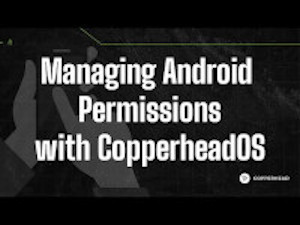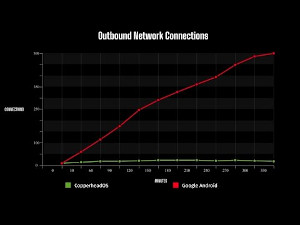CopperheadOS usage guide
Usage guide for the Secure Android CopperheadOS
CopperheadOS is a Linux-based mobile operating system with a focus on privacy and security. It builds on the latest stable release of the Android Open Source Project (11) which is Android without any Google apps or services. CopperheadOS is considered 'de-Googled' in so far that a default CopperheadOS install has no Google Mobile Services or Play Store to interact with.
This usage guide documents the user experience with the OS focusing on how it compares to the Android operating system. Most security features are kept unobtrusive without a user-facing impact. See the technical overview for documentation on the security features rather than only changes to the user experience.
CopperheadOS can run Android apps unless they have a hard dependency on Google services. The F-Droid App Store is included to provide simple access to thousands of open source Apps. CopperheadOS is compatible with most Android Apps. Apps which make use of Google Mobile Services and/or Firebase will have diminished functionality where those services are implemented.
Since it doesn't include Google Apps or Services, CopperheadOS is not limited by requirements imposed by Google for an operating system to be considered Android compatible. It disregards the constraints required to actually be Android while still retaining the ability to run nearly all real world Android apps not tied to Google. Android devices aren't permitted to ship many of the features documented below like the Network permission toggle.
Bug reports
Bug reports are helpful way for CopperheadOS customers to seamlessly send reports to Copperhead for view. Personal information is scrubbed from the bug report and is automatically submitted anonymously if no email is input at the submit screen.
Notifications
Apps which rely entirely on Google Mobile Services (GMS) for delivery of notifications will not work properly. Apps that do not rely on GMS for notifications will be capable, but may require a set of manually set permissions for full functionality.
Many Apps found in the Recommended Apps section of this guide have features which make management of these notifications much easier.
Home screen Notifications
On the Home screen in a spot away from any Apps, tap and hold for a few seconds until the context menu appears. Select Home screen settings. Here you can grant permission for the Quick Step service to handle notifications. It will use this permission to provide context cues (notification dots) on the Home screen when Apps have notifications for the user.
Battery optimization
By default, Battery optimization is enabled for most Apps in CopperheadOS. To ensure timely delivery of important notifications, it may be necessary to disable battery optimization. This can be accomplished on a CopperheadOS device by navigating to Settings -> Apps & notifications -> Advanced -> Special app access -> Battery optimization. Select All Apps from the dropdown menu at the top of the screen, then find the App you wish to disable Battery optimization for.
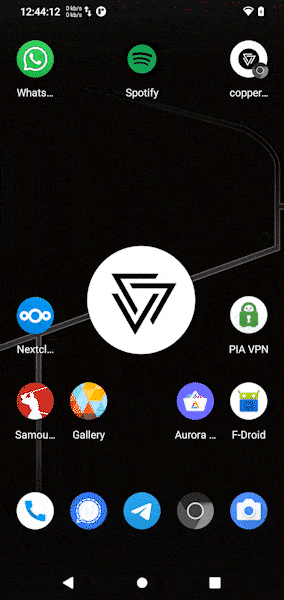
Nextcloud
This section contains advisories and how-tos for using Nextcloud with a CopperheadOS Secure Android.
Nextcloud Files
The Nextcloud Files Android App is the primary point of contact for your self-hosted Nextcloud server and your CopperheadOS device. This App can be installed on your CopperheadOS Pixel device at setup or later from F-Droid, a Google Play Store interface such as Aurora Store or from the Nextcloud Developer site.
Note regarding Nextcloud Files setup and Seedvault back-ups: If Seedvault does not allow you to initialize a back-up location using the Nextcloud Files App you recently installed you may need to disable the app passcode within the Nextcloud Files App itself. To Navigate to this setting:
- Tap the hamburger menu next to the search bar in the Nextcloud Files App -> Tap Settings -> Find App passcode under Details and set to None.
Calendar, Contacts and Email
Syncing contacts and calendar entries as a complete Cal/CardDAV replacement is possible on CopperheadOS thanks to various open-source tools. The requirement for a complete officesuite replacement is a full suite like Nextcloud or using a Sync Adapter such as DAVx5 and an application that can interpret the synced data, such as Etar (included in CopperheadOS). Email notification compatibility relies on the application being deGoogle compatible.
CopperheadOS does not currently ship with an email client. For this reason, we recommend using an opens source offering such as FairEmail or a paid service for encrypted email such as Tutanota.
FairEmail
FairEmail is an open source, privacy and security focused offering. FairEmail is available through Aurora Store, F-Droid or on GitHub. We recommend our users install either from the GitHub releases page or through Aurora Store to ensure full OAuth capability for the client.
Tutanota
Tutanota offers their encrypted email client on F-Droid. Tutanota offers free services for individuals, subject to a 24 hour confirmation period before the account is usable.
DAVx5 and Etar
Note that end-to-end encrypted calendar/contacts can't work using DAVx5 and must be synced inside of their respective solution.
The steps to hook up contacts and calendar via DAVx5/Etar are as follows:
- Find your providers' DAV instance ports and addresses. For example, Fastmail.
- Use DAVx5 to interface with your provider
- In Etar: open Settings and verify your calendars are connected from DAVx5
- DAVx5 also makes Android Accounts: Settings -> Accounts should display your available calendar/contacts
- Note that DAVx5 defaults to syncing only over WiFi
ToDo Widget Agenda
Currently (2020-11) Etar does not provide a means to have a Calendar widget on the default workspace. CopperheadOS includes Todo Widget Agenda that provides the Calendar widget functionality in conjunction with Etar.
To get a Calendar widget displaying on your CopperheadOS workspace:
- Long press on the workspace
- Select widgets
- Select ToDo Agenda and drag the widget to your workspace
App recommendations
Built-in user-facing apps
CopperheadOS includes most of the standard Android Open Source Project (AOSP) apps.
The following apps are actively developed as part of AOSP and receive both bug fixes and new features. Using these apps rather than third party ones is highly recommended:
- Calculator
- Clock
- Contacts
- Files
- Launcher
- Phone
- Settings
- Gallery
The following apps are no longer actively developed as part of AOSP and only receive important security fixes. These apps will keep working indefinitely since Android is backwards compatible but they won't receive new features or overhauls. These are candidates for replacement or aren no longer included in CopperheadOS, and users should make use of Third Party Apps in their place.
- Camera
- Email (Currently no Email App is included in CopperheadOS)
- Music (Currently no Music App is included in CopperheadOS)
- Search (launcher icon is removed in CopperheadOS, but it's included for compatibility)
Some of the AOSP apps have been replaced in CopperheadOS:
- Calendar -> Etar (maintained derivative of the backend-agnostic AOSP Calendar app, can be used with any service exposing a calendar backend via an app)
- Browser -> Chromium (hardened browser developed by CopperheadOS based on Chromium, see the section on browsing)
- Messaging -> Silence (replaced to provide end-to-end SMS encryption)
CopperheadOS also includes some additional built-in apps. These apps are included to provide functionality missing in AOSP compared to stock Android or in the case of Net Monitor because it can't work if it's not integrated with the OS due to CopperheadOS privacy enhancements.
- F-Droid: app repositories and updates
- Net Monitor: monitoring network connections
- PDF Viewer: hardened PDF viewer developed alongside CopperheadOS
- Todo Agenda Widget: extending functionality for Etar to place widget on Homescreen
Installing apps from the Play Store
The Aurora Store app on F-Droid can be used to install apps from the Play Store. Before using it to install an app, press the menu button, press Settings and enable the toggle for 'Download to internal storage' to make sure Aurora Store doesn't download apps to shared storage where other apps with storage access could potentially tamper with them before installation. Aurora Store will still demand the Storage permission even though it isn't required though.
It's not clear how Google feels about the Aurora Store Store app so we don't recommend using your own account credentials unless it's a throwaway account. Stick to the Aurora Store Store credentials. If you need apps that you've purchased, consider using F-Droid's support for swapping apps between devices to get them from a trusted device with the Play Store. Note that many paid apps use DRM which won't work without Play Services.
Many apps from the Play Store use Google Play Services, but lots of those will still work fine on CopperheadOS. Some functionality like push notifications may not be available if the apps don't implement fallbacks for systems without Play Services included in the OS.
Be careful when installing apps from the Play Store and granting permissions to them since overall they're a lot less trustworthy than the apps in the F-Droid repositories enabled by default on CopperheadOS. There are apps in F-Droid with serious privacy and security issues but there aren't any known cases of malicious apps and they tend to be a lot more respectful of privacy with most of the major deviations from that marked in the F-Droid entries for those apps.
Browsing
CopperheadOS ships hardened builds of Chromium and the robust rendering sandbox makes it the most secure option available. Since the Android WebView is provided by Chromium, most apps render web content using the CopperheadOS Chromium builds. For example, DuckDuckGo uses the WebView in their search app and the CopperheadOS PDF Viewer uses it to render PDF documents. CopperheadOS enables the rendering sandbox for the WebView since Android Nougat and Google will be enabling it with Android O, but the standalone browser sandbox is currently more restrictive. The WebView is also at the mercy of the security of the app using it, since apps can add their own interfaces and can grant access to the same files and other content they can access outside of the WebView.
Music
The default AOSP Music application is not available on CopperheadOS because of it's lack of maintenance. Spotify is fully supported in CopperheadOS through download on the Aurora Store.
Driving and Directions
Waze is fully supported in CopperheadOS through download on the Aurora Store. Note that Waze can and has made breaking changes to the application that may affect CopperheadOS functionality. Waze is by no means privacy-default but is a good alternative for now.
Red shift / Night Light
On Pixels, use Settings -> Display -> Night Light instead of a third party app requiring a grant of the special "Display over other apps" permission.
OpenCamera
Install the Open Camera app from F-Droid and enable "Use Camera2 API" in the settings menu. This enables support for features like manual ISO configuration and HDR (not HDR+) mode.
On the Pixel 2 and Pixel 2 XL, HDR+ via the Pixel Visual Core is available to apps on CopperheadOS with support for it. Unfortunately, the AOSP Camera app doesn't currently support it.
Uber
Use https://m.uber.com/ instead of the Android app. Open it with Chromium and select 'Add to Home screen' from the menu. Unlike most sites, the Uber web app is set up to act as a standalone app when added to the home screen rather than the launcher only acting as a bookmark and opening a Chromium tab. The map isn't enabled by default since the web app is aimed at the niche of users with low bandwidth but it can be enabled.
Chromecast
VLC supports casting to Chromecast devices, so support within the OS provided by Play Services isn't required.
Messaging
Recommended messaging app preference list:
- Conversations + OMEMO
- Signal to communicate with Signal users and for encrypted calls
- Silence encrypted SMS to communicate with Android users without data connections
- Other apps with end-to-end encryption if you can't convince contacts to install one of the above (Wire, WhatsApp, Telegram etc.)
Conversations
Conversations is an XMPP client inter-operable with other XMPP clients and servers. It supports end-to-end encryption via robust cryptography (OMEMO) based on the Signal protocol along with OTR and PGP for backwards compatibility with lesser clients. It's one of very few apps with efficient push messaging without needing Google Cloud Messaging (GCM). It also supports end-to-end encrypted group chat.
Conversations has an official XMPP server with all of the necessary extensions for full functionality. It costs 8 EUR / year after the 6 month free trial. Using the official server to support the project is recommended, but there are other options without a subscription fee. We don't currently have a recommendation about which ones to prefer, beyond sticking to those with support for every XEP other than XEP-0357 (which is for GCM, rather than the standard push mechanism).
Signal
The official website releases of Signal can either be installed from their site but this requires temporarily enabling installing apps from your browser (it still requires consent each time) or installed via Aurora Store (which allows for manual upgrading). The Signal APK will check for updates to itself and notify about them but it can't support the option of automatic upgrades. The upgrades need to be installed by hand and require enabling app installs from Signal (it still requires consent each time).
Silence (Deprecated - Removed Q1 2021)
CopperheadOS replaces the AOSP Messaging app with Silence to provide support for encrypted SMS. It isn't really recommended to prefer it over data-based encrypted messaging apps, but rather to make use of it for communicating with contacts without data connections, or for all messaging if you don't have a data connection yourself. It makes sense to leave it as the default SMS app even if you're using an app like Noise able to act as the default SMS client. Silence is currently broken on the latest Android versions (2020 - Android 10) and may be deprecated in future CopperheadOS installations.
Telegram
Copperhead hosts a news channel for broadcast of Copperhead and CopperheadOS related news.
Telegram is another messaging application with a wide adoption rate. Telegram has certain security implications with it's use. End-to-end encryption in Telegram is only enabled for "Secret Chats" and thus caution should be noted for any normal Telegram chats.
Optimal Telegram Settings
Telegram has a few settings which provide optimal functionality on a CopperheadOS device. As usual for AOSP builds without Google the Battery Optimization option will have to be disabled for Telegram.

WhatsApp works on CopperheadOS and is available via Google Play interfaces such as Aurora Store. The best way to use it is probably installing the Amazon Appstore as an apk and then installing it from there, so that you have updates for it along with the Appstore which will update itself. WhatsApp uses Facebook's infrastructure for push notifications and thus can receive push notifications on CopperheadOS devices.
YouTube
Use the NewPipe app from F-Droid if you want more functionality than the mobile site.
Maps
maps.me
The all around best option for basic map and navigation functionality is maps.me but it has some privacy and security issues.
The com.github.axet.maps fork is available in the standard F-Droid repository with the ads, binaries, etc. stripped out.
The official maps.me apk is available on their site and the Play Store version works perfectly well on CopperheadOS too.
The main issue with it is that there's no way to have it use internal app storage instead of using shared storage for internal app data like settings and map downloads. The data is exposed to other apps with storage access and could be tampered with or simply watched for location information. It might be something that the fork would be willing to address. Feel free to encourage both projects to take a more secure approach or at least offer it as an option.
OpenStreetMap
OsmAnd (OpenStreetMap Automated Navigation Directions) can be installed from F-Droid and provides map viewing and mobile navigation. It has the killer feature of optional support for downloading the OpenStreetMap database for chosen regions. In addition to the obvious advantage of not having a dependency on an internet connection, offline mapping offers more privacy. It's recommended to use the offline mode if you have enough storage space to spare. Note that it's important to configure OsmAnd to use the internal storage directory: go into the menu, then Settings, General settings, select the "Data storage folder" option, select the edit button and set it to the "Internal application memory" option.
Note that OsmAnd sends the semi-persistent ANDROID_ID to their server on connections. ANDROID_ID will become less identifying in future CopperheadOS releases by default and further user control will be offered, but it reflects poorly on OsmAnd.
Google maps
If you really need Google Maps, you can use their web application (maps.google.com). It's not as nice as the mobile app but the core functionality other than turn-by-turn navigation is there.
Permission model
Apps run in an application sandbox with access to little more than their internal data and interfaces explicitly exported to them from the base system and other apps. Most of their capabilities need to be granted by the permission system. Permissions are divided into normal permissions like the ability to set an alarm or start at boot and dangerous permissions that need to be explicitly granted by users.
CopperheadOS and stock Android use the same runtime permission model for apps targeting the modern Android platform. Dangerous permission groups (camera, contacts, microphone, etc.) are disabled by default and apps need to request them from the user as needed with the expectation that they attempt to handle not getting the permissions. The dangerous permission groups can also be toggled via Settings -> Apps & notifications -> App info -> App name -> Permissions and modern apps can be expected to handle this and request the permissions again as needed. Dangerous permission groups can also be audited / toggled by group instead of by app using Settings -> Apps & notifications -> App permissions.
For apps targeting old versions of the Android platform, stock Android grants all requested dangerous permissions at install time. The dangerous permission groups can still be toggled off via Settings -> Apps & notifications -> App info -> App name -> Permissions and provide empty data where possible rather than failing for compatibility. By contrast, CopperheadOS presents the user with a menu where they can review and disable dangerous permission groups before the app is able to run. The substantial difference is that stock Android doesn't give the user a chance to toggle off permissions before the app is able to run. Installing it and toggling them off before manually launching the app is not adequate as it's possible for it to be started before that.
Note that Android makes it possible for apps to get by without permissions in most cases. An app can have the user pick a contact, take a picture, store / open a file in a storage provider, etc. without any permissions required. Be skeptical about the justification given by app developers for their permission usage. For example, many claim to need to read the phone state (Phone permission group) to detect an active phone call but it's almost always a false justification as they could be using the standard audio focus mechanism.
Network permission
Unlike stock Android, CopperheadOS treats full network access as a user-facing permission with a toggle. For compatibility, it's enabled by default for apps targeting the modern Android platform unlike other runtime permissions.
There are many known cases of apps exporting interfaces to other apps for making limited network requests, so this toggle will become more useful when further isolation options are available. For example, web browsers almost all expose an interface allowing other apps to open URLs and choose not to require either the INTERNET permission or explicit user consent before making the request.
Sensors permission
Unlike stock Android, CopperheadOS treats sensor access as a user-facing permission with a toggle. For compatibility, it's enabled by default for apps targeting the modern Android platform unlike other runtime permissions. Stock Android only treats heartbeat sensor access as dangerous.
Unlike the Network toggle, apps aren't marked with an existing low-level permission when they make use of sensor access. CopperheadOS adds a new permission and treats all apps as requesting it so there's a sensor permission toggle for every app.
Sensor access has been shown to provide the capability to perform location tracking, input logging and crude audio recording that's still capable of recognizing speech despite the 200 Hz sampling limit enforced by the OS.
Background access
CopperheadOS adds special permissions for controlling access to data in the background in Settings -> Security -> Apps with background access.
This feature will become more strict in the future. It's an early implementation aimed at fleshing out the full set of functionality and working towards disabling access by default.
The powerful 'draw over other apps' special permission can be used to remain in the foreground. It needs to be explicitly granted by users in a more manual way than the usual dangerous permission request dialog and a persistent notification is displayed while it's being used. It also can't be used to draw over the system ui to hide the persistent notification. It's outside of the scope of this feature as it's quite dangerous already and should only be granted to an app in exceptional circumstances just like accessibility services and device administrators.
Clipboard
CopperheadOS disables access to the clipboard by apps in the background by default. This can be enabled per-app via Settings -> Security & location -> Apps with background access -> Access clipboard in the background. For example, you may need to whitelist a clipboard manager.
Audio recording
Initiating audio recording in the background can be disabled per-app via Settings -> Security & location -> Apps with background access -> Record audio in the background. It isn't yet disabled by default but will be in the future.
For now, apps can still initiate audio recording in the foreground and continue in the background even with background audio recording disabled. The feature will eventually be improved to kill apps with an open recording stream when they're sent to the background.
Sensors
Sensors access in the background can be disabled per-app via Settings -> Security & location -> Apps with background access -> Access sensors in the background. It isn't yet disabled by default but will be in the future.
Location
Location access in the background can be disabled per-app via Settings -> Security & location -> Apps with background access -> Access location in the background. It isn't yet disabled by default but will be in the future.
Serial number
CopperheadOS requires that apps have the Phone permission group (read phone state) to access the serial number just like the IMEI on stock Android. Android is moving towards this but doesn't yet enforce it even for apps targeting Android Oreo.
Display over other apps
Unlike stock Android, CopperheadOS doesn't permit any automatic grants of the special "Display over other apps" permission. It needs to be very explicitly granted by users.
Storage
Apps have their own private storage directories and can share files with other apps using content providers. Apps can act as storage providers to provide structured requests to retrieve and store data including for the shared storage directory. Direct scoped access can also be requested for the shared storage directory (since 7.0). Unfortunately, many apps require the storage permissions for direct, full access to shared storage so it's unwise to store sensitive data there.
In the future, CopperheadOS will offer the ability to isolate shared storage rather than toggling access. Isolated shared storage will provide an app with a dedicated shared storage directory accessible only to themselves and the built-in file manager. Ideally, apps would already use the available tools to provide this kind of functionality on their own.
File management
The built-in file manager for shared storage is recommended. It's available as the Files app on the home screen and is also accessible via Settings -> Storage -> Files. Shared storage can be shown by enabling by "Show internal storage" in the app menu. It has proper integration with storage providers (apps providing storage to other apps, with explicit user control) and external storage. It will also be the only app able to access isolated shared storage directories of other apps once that feature is implemented.
Location
The location icon is displayed in the status bar when an app is monitoring the device's location.
Settings -> Security & Location -> Location provides a global toggle to disable location detection along with a list of apps that have made recent location requests.
Backup and Restore
Seedvault, an encrypted backup and restore application, is integrated into CopperheadOS to provide users with a seamless backup/restore process.
- Settings -> System Settings -> Backup
User profiles
User profiles offer isolated workspaces within the operating system.
Fully opening the notification tray will show an avatar for the main user profile. Touching it opens the menu for creating and switching between profiles. Further configuration is available via 'More settings' which is a shortcut to Settings -> Users & accounts -> Users.
The special Guest profile is meant to be used as a scratch space with a quick shortcut in the notification tray for deleting everything in the profile. It also offers the option to clear it when switching to it.
Apps cannot communicate or share data across user profiles. On Pixel phones, each user profile has separate disk encryption keys for all user data rather than there being a shared boot password. A profile also cannot record audio while another profile is active. By default, only the Owner account has access to phone calls and SMS. It can be enabled for other accounts via the user settings menu on the owner account.
In addition to the baseline functionality, CopperheadOS exposes option to disallow audio recording and to disallow installing apps in the user configuration menu for the owner account.
Force always on Tor / VPN
In Settings -> Network & Internet -> VPN, the gear icon next to installed VPN apps like Orbot (Tor) can be used to set one as an "Always-on VPN" to make it start automatically. However, it's also necessary to toggle on "Block connections without VPN" to disallow connections being made if the VPN dies. This will be enabled by default for an "Always-on VPN" on CopperheadOS in the near future.
Setting up a WiFi Hot Spot with always on VPN for connected clients
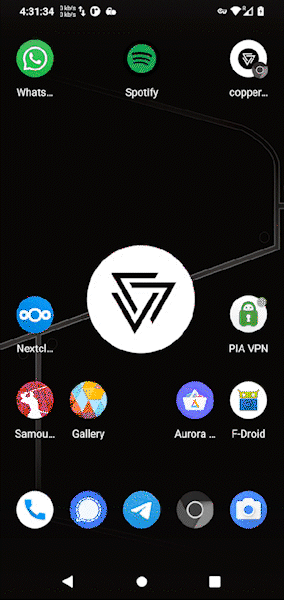
Performing a Factory Reset on a Pixel family device
Factory resetting your device will not remove CopperheadOS, and your device firmware will not be modified. Data on the CopperheadOS device should be backed up before performing the factory reset.
Factory Reset via Android Recovery
To perform a factory reset on a Pixel family device from the bootloader, follow the instructions below.
- Power off the device completely. If your device is locked or you cannot power off the device normally for any reason, press and hold the Power key until the screen is blank.
- With the device off, press and hold both the Power key and the Volume Down key together. You should now see the fastboot menu.
- There will be a selection menu next to the Power key. Use the Volume Down key to choose the "Recovery Mode" option and then press the Power key to enter Recovery Mode.
- When the green Android appears, press and hold the Power key and tap Volume Up. You should now see the Recovery menu.
- Use the Volume Down key to highlight the "Wipe data/factory reset" option. Press the Power key to proceed, and then use the Volume Down key to highlight "Factory reset data" and press the Power key once more to confirm.
- When the words "Data wipe complete" appear at the bottom of your device screen, check that "Reboot system now" is highlighted, then press the Power key to restart your device. If "Reboot system now" is not highlighted, use the Volume keys to highlight it and press the Power key to restart your device.
Factory Reset via CopperheadOS
- Settings -> System Settings -> Reset Options -> Erase all data (factory reset)
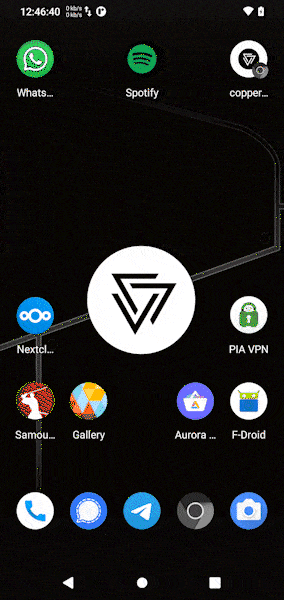
Android Safe Mode
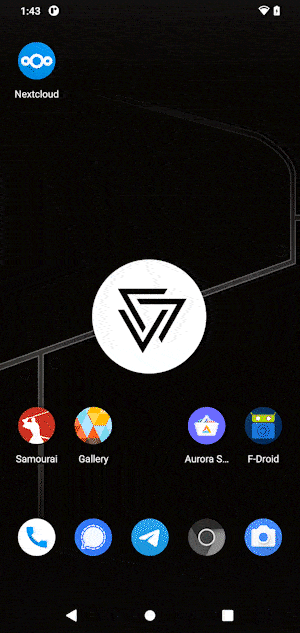
Safe Mode will reboot your CopperheadOS device with all third-party Apps disabled. This can be useful when your device is underperforming, exhibiting strange behaviours and other troubleshooting purposes.
To enter Safe Mode:
- Boot the device
- Long press the Power Key until the Power Menu appears
- Long press Restart
- Press OK when prompted to confirm
Android Recovery Mode

For security purposes, CopperheadOS's recovery has various Android Recovery mode options disabled. Users are restricted from downgrading the OS, enabling security-breaking mechanisms like ADB and are restricted from side-loading alternative Operating Systems via SD cards. Unlike various 3rd party ROM's and some Android devices data cannot be extracted from the CopperheadOS recovery menu.
Android Data Recovery
CopperheadOS is a security-first Secure Android and does not compromise user's safety for convenience. A lost CopperheadOS device or a lost password for a CopperheadOS device has the same unfortunate but important conclusion that it cannot be accessed remotely, unlocked and data cannot be extracted from the device. Copperhead has no remote access capabilities and cannot assist 1st or 3rd parties in retrieving data from a locked/lost device. Lost passwords are a troublesome issue and organizations using CopperheadOS devices should ensure it's password compliance policy stays up to date alongside password safety storage.
Native debugging
Support for native debugging features can be disabled by toggling off Settings -> Security & Location -> Enable native code debugging. It's left enabled by default like stock in order to generate useful logs and crash dump information from crashes tied to bugs in native code. Disabling it will make the information generated by the 'Take bug report' feature nearly useless for crashes caused by native code but it will still produce useful information for uncaught Java exceptions. There are currently no known app compatibility issues caused by disabling this, but it isn't compatible with some nasty tricks used by obfuscated apps to make themselves harder to inspect.
USB peripherals
CopperheadOS defaults to ignoring connected USB peripherals if the screen is locked. This can be controlled in Settings -> Security & Location -> USB accessories. The options are:
- Disallow new USB peripherals
- Allow new USB peripherals when unlocked (default)
- Allow new USB peripherals (like stock Android)
This option has no impact on the device acting as a USB peripheral itself when connected to a computer. However, Android already defaults to charge only mode and requires explicit opt-in to the device exposing itself as an MTP, PTP or MIDI device.
Camera on lockscreen
CopperheadOS adds a toggle at Settings -> Security & Location -> Camera on lockscreen for reducing lockscreen attack surface by disallowing camera usage. It disables both the camera launch icon in the lower right corner of the lockscreen and camera launch gestures while locked.
Quick Settings restrictions
CopperheadOS restricts usage of sensitive Quick Settings tiles while the screen is securely locked.
The following Quick Settings tiles have an unlocking requirement in stock Android:
- Cast
- Location
CopperheadOS extends this requirement to more tiles:
- Bluetooth
- NFC (not present as a tile in stock)
- Airplane mode
- Wi-Fi
- Auto-rotate
- Data Saver
- Hotspot
- Cellular data
- Battery
Some tiles still have no unlocking requirement:
- Flashlight
- Night Light
- Invert colors
- Do not disturb
- Work
The 'Flashlight' tile is quite useful from the lockscreen and adds minimal attack surface.
'Night Light' and 'Invert colors' are comparable to the brightness slider. They add minimal attack surface and are easy to notice and toggle off. Similarly, 'Do not disturb' (DND) is comparable to the volume rocker which works while locked and both are quite useful functionality to have there. The volume rocker already allows setting the 'Alarms only' DND mode too.
Android for Work isn't currently in scope for CopperheadOS hardening and the Work tile isn't available when it's not in use, so it has been left as is. Android for Work isn't aimed at businesses deploying dedicated work devices but rather Bring Your Own Device (BYOD).
Wi-Fi
Scanning
MAC randomization is always enabled for Wi-Fi scanning. The Nexus 5X and Pixel phones have fairly unique firmware support for scanning MAC randomization going above and beyond the usual implementation. On most other devices, there are identifiers exposed by Wi-Fi scanning beyond the MAC address such as the packet sequence number and assorted identifying information in the probe requests.
Wi-Fi scanning is never performed when Wi-Fi is disabled without explicitly enabling it in Settings -> Security & Location -> Location -> Scanning, unlike stock Android. The same thing applies to Bluetooth.
Avoid using hidden APs (i.e. APs not broadcasting their SSID) since known hidden SSIDs end up being broadcast to find them again. SSIDs are not broadcast for standard non-hidden APs.
Privacy when associated with an Access Point (AP)
The DHCP client uses the anonymity profile rather than sending a hostname so it doesn't compromise the privacy offered by MAC randomization.
Unlike stock Android, CopperheadOS also provides MAC randomization when associated with an AP. This is currently exclusive to Pixel phones and can be toggled off in Settings -> Network & Internet -> Wi-Fi -> Wi-Fi preferences -> Randomize MAC address which will restore the hardware MAC address when Wi-Fi is toggled off and on again.
LTE only mode
If you have a reliable LTE connection from your carrier, you can reduce attack surface by disabling 2G / 3G connectivity in Settings -> Network & Internet -> Mobile network -> Preferred network type. Traditional voice calls will only work in the LTE only mode if you have either an LTE connection and VoLTE (Voice over LTE) support or a Wi-Fi connection and VoWi-Fi (Voice over Wi-Fi) support. VoLTE / VoWi-Fi on Pixel phones is expected to work on all carriers where it's supported on stock (T-Mobile, Rogers, Fido, etc.) other than Verizon. VoLTE / VoWi-Fi compatibility is substantially worse on Nexus devices for now.
This feature is not intended to improve the confidentiality of traditional calls and texts, but may somewhat raise the bar for some forms of interception. It's not a substitute for end-to-end encrypted calls / texts or even transport layer encryption. LTE does provide basic network authentication / encryption but it's for the network itself. The intention of the LTE only feature is only hardening against remote exploitation by disabling an enormous amount of legacy code.
Network connection information / statistics
CopperheadOS prevents third party apps from obtaining detailed network information without any permissions as they can on stock Android. The Net Monitor app is built into CopperheadOS and has a special exception from this rule. Network information can also be accessed via the Android Debug Bridge shell. Third party apps can only access information that's made explicitly available via documented interfaces with permission controls and there's essentially no access to it right now as valid use cases for it by third party apps not covered by Net Monitor haven't been presented. The only known examples of using the information in good faith haven't been correct, such as the attempts to implement a user-facing firewall via a VPN service rather than properly integrated via the existing OS firewall infrastructure so that it actually works properly.
Default connections made by CopperheadOS
Applications such as Netguard can be used to monitor connections by the OS in addition to those done by apps. The DownloadManager service will do HTTP / HTTPS downloads on behalf of third party apps and those shouldn't be confused with downloads triggered by the OS itself.
CopperheadOS makes connections to the outside world to test connectivity, detect captive portals and download updates. No data varying per user / installation is sent in these connections. There aren't analytics / telemetry in CopperheadOS.
The expected connections by CopperheadOS (including all base system apps) are the following:
- The CopperheadOS Updater app fetches update metadata from https://SERVER/DEVICE-CHANNEL every hour when connected to a permitted network for updates.
- F-Droid performs update checks for enabled repositories. By default, the standard F-Droid repository is enabled.
- As with other devices with a Qualcomm baseband (which provides GPS), GPS almanac updates from Qualcomm are downloaded from https://xtrapath1.izatcloud.net/xtra3grc.bin, https://xtrapath2.izatcloud.net/xtra3grc.bin or https://xtrapath3.izatcloud.net/xtra3grc.bin. CopperheadOS has modified all references to these servers to use HTTPS rather than a mix of HTTP and HTTPS.
- Connectivity checks designed to mimic a web browser user agent are performed by using HTTP and HTTPS to fetch standard URLs generating an HTTP 204 status code. This is used to detect when internet connectivity is lost on a network, which triggers fallback to other available networks if possible. These checks are designed to detect and handle captive portals which substitute the expected empty 204 response with their own web page. These need use a very common domain and URL in order to bypass whitelisting systems only permitting access to common domains / URLs so a domain like copperhead.co would be inadequate.
- CopperheadOS leaves these set to the standard four URLs to blend into the crowd of billions of other Android devices with and without Google Mobile Services performing the same empty GET requests:
- HTTPS: https://www.google.com/generate\_204
- HTTP: http://connectivitycheck.gstatic.com/generate\_204
- HTTP fallback: http://www.google.com/gen\_204
- HTTP other fallback: http://play.googleapis.com/generate\_204
- DNS connectivity and functionality tests
- DNS resolution for other connections
The connectivity checks are performed by both the OS itself and the hardened Chromium browser.
DNS
Unlike stock Android, CopperheadOS uses Cloudflare's DNS servers for network connectivity tests and the default fallback when the network doesn't provide DNS servers. This decision is based on Cloudflare providing a stellar privacy policy compared to the decent one for Google Public DNS. Cloudflare DNS supports DNS-over-HTTPS and DNS-over-TLS so it will be possible to use it with Android's upcoming DNS-over-TLS support.
In practice, the default fallback is rarely used. DNS servers provided by the local network are preferred for both mobile data and Wi-Fi, since it avoids trusting an additional party with the information. The local network and ISP can still obtain all of the information when using an alternate DNS server. Hiding the information from them requires using a VPN to move the same trust to the VPN provider which is hopefully more worthy of that trust than the ISP. Even when using DNS-over-HTTPS or DNS-over-TLS, tracking IP addresses leaks nearly as much information and even HTTPS connections leak the hostname (unlike the path) so very little is truly being hidden by those technologies.
Android 9.0 added support for overriding the default DNS servers with a DNS-over-TLS server chosen by the user. However, as noted above this won't be able to hide much information from the local network and ISP. It has some value but is limited, particularly before there's some form of encrypted SNI extension for TLS 1.3 to avoid leaking exact hostnames for HTTPS rather than only having imprecise reverse DNS lookups.
It's possible for apps implementing the VPN service feature to provide alternative DNS servers and it can be done without intercepting and routing network traffic like a real VPN. Some apps use this to implement features like domain-based content filtering.
App spawning time
You may notice that cold start app spawning time takes a bit longer (i.e. in the ballpark of 100ms) than stock Android due to security centric exec spawning feature. This is most noticeable on the Nexus 5X due to it being the slowest supported device and is far less significant on current generation hardware. It doesn't cause any performance cost after launching an app, and similarly doesn't cause any extra latency if the app was already running / cached in the background.
Updates on Pixel phones
The update system implements automatic background updates. It checks for updates once per hour when there's network connectivity and then informs the user of the download and prompts to install updates in the background. It will pick up where it left off if downloads are interrupted, so you don't need to worry about interrupting it. Similarly, interrupting the installation isn't a risk because updates are installed to a secondary installation of CopperheadOS which only becomes the active installation after the update is complete. Once the update is complete, you'll be informed with a notification and simply need to reboot with the button in the notification or via a normal reboot. If the new version fails to boot, the OS will roll back to the past version and the updater will attempt to download and install the update again.
The updater will use incremental updates to download only changes rather than the whole OS unless the current version is behind the current release by more than 3 versions. As long as you have working network connectivity on a regular basis and reboot when asked, you'll almost always be on one of the past couple versions of the OS which will minimize bandwidth usage since incrementals will always be available. If you fall more than 3 versions behind, it will download a large full update shipping the full OS so it can update from any version.
The updater works while the device is locked / idle, including before the first unlock since it's explicitly designed to be able to run before decryption of user data.
Settings
The settings are available in the Settings app in System -> About phone -> Update settings.
The "Release channel" setting can be changed from the default Stable channel to the Beta channel if you want to help with testing. The Beta channel will usually simply follow the Stable channel, but the Beta channel may be used to experiment with new features.
The "Permitted networks" setting controls which networks will be used to perform updates. It defaults to using "Unmetered" network connection to ensure customers don't overrun data SIM plans. It can be set to "Non-roaming" to disable it when the cellular service is marked as roaming or "Unmetered" to disable it on cellular networks and also Wi-Fi networks marked as metered.
The "Require battery above warning level" setting controls whether updates will only be performed when the battery is above the level where the warning message is shown. The standard value is at 15% capacity.
Enabling the opt-in "Automatic reboot" setting allows the updater to reboot the device after an update once it has been idle for a long time. When this setting is enabled, a device can take care of any number of updates completely automatically even if it's left completely idle.
Update security
The update server isn't a trusted party since updates are signed and verified along with downgrade attacks being prevented. The update protocol doesn't send identifiable information to the update server and works well over a VPN / Tor. Copperhead isn't able to comply with a government order to build, sign and ship a malicious update to a specific user's device based on information like the IMEI, serial number, etc. The update server only ends up knowing the IP address used to connect to it and the version being upgraded from based on the requested incremental.
Android updates support serialno constraints to make them validate only on a certain device but CopperheadOS rejects any update with a serialno constraint for both the Stable and Beta channels.
Disabling updates
It's highly recommended to leave automatic updates enabled and to configure the permitted networks if the bandwidth usage is a problem on your mobile data connection. However, it's possible to turn off the update client by going to Settings -> Apps, enabling Show system via the menu, selecting CopperheadOS Updater and disabling the app. If you do this, you'll need to remember to enable it again to start receiving updates.
Authentication / encryption
Using a strong passphrase is recommended. CopperheadOS extends the arbitrary default maximum passphrase length from 16 characters to 64 characters.
Pattern unlock is strongly discouraged and may be turned into a hidden option in the future.
Fingerprint unlock acts as an extremely convenient secondary unlock mechanism. However, it opens up weaknesses compared to knowledge-based authentication. It's not usable after a reboot for the first unlock or after 48 hours and it doesn't reduce authentication or encryption security in those cases. It has the important redeeming quality of making a strong passphrase as the main unlock mechanism very convenient and the placement of the scanner can make it even more convenient than swipe to unlock or even the no unlock mechanism option (i.e. power button only).
The long-term plan for CopperheadOS is to build upon fingerprint unlock by adding support for setting an optional knowledge-based 2nd factor. Once that's implemented, the only recommended authentication setups will be the following, from strongest to weakest:
- Strong passphrase
- Strong passphrase with fingerprint + PIN (or weaker passphrase) as a secondary unlock mechanism
- Strong passphrase with fingerprint as a secondary unlock mechanism
Until it's implemented, using a PIN or a weak passphrase instead of the second option can make sense. It's much weaker in the case where fingerprint unlock isn't available, i.e. after a reboot or the 48 hour timeout.
CopperheadOS supports randomizing the PIN entry layout via a toggle in Settings -> Security & Location -> Passwords -> Scramble PIN layout, which is disabled by default. This will apply to the planned 2nd factor fingerprint unlock mechanism in addition to using a PIN as the main unlock method, which will be discouraged once there's a better option available.
Fingerprint unlock attempts
CopperheadOS disables fingerprint unlock after 5 failed attempts, unlike stock Android which allows 20 attempts with 30 second delays after each 5 failed attempts.
You can use this to disable the fingerprint scanner by intentionally making invalid unlocking attempts. The device will vibrate on invalid unlocking attempts and will stop vibrating once fingerprint unlock has been disabled.
Keyboard personalized suggestions
The keyboard has the option of maintaining an internal database to improve suggestions based on past input. It's entirely local and inaccessible to any other apps like all internal app data, but CopperheadOS disables it by default to avoid gathering persistent statistics about user input that may be valuable to an attacker that has compromised the device. It can be enabled again in Settings -> Languages & input -> Virtual keyboard -> CopperheadOS Keyboard -> Text correction -> Personalized suggestions, which is also accessible by holding the comma key on the keyboard and pressing CopperheadOS Keyboard Settings.
Verified boot
CopperheadOS only supports devices with verified boot support. The hardware verifies authenticity and integrity of firmware and the core operating system on every boot. The core operating system verifies the entire rest of the operating system, providing full verified boot for the OS. Every installation is guaranteed to be bit-for-bit identical at a storage level, otherwise it wouldn't work. Updating the OS updates it to a pristine installation of a new release.
A fresh installation or an incremental update shipping only changes to blocks provide exactly the same result. If any block fails to verify, the OS has error correction data to attempt to fix the issue before verifying the fixed block again. If the corruption cannot be fixed, an error will be displayed and it will reboot.
An attacker that has successfully gained root access via an exploit chain cannot simply modify any of the OS partitions. They would need to have an exploit for the verified boot process to exploit it as it reads their altered data which is an extremely high bar. This greatly raises the bar for privileged persistence. An attacker is forced to persist as an unprivileged third party app, requiring exploitation of the OS via an unpatched vulnerability to gain back control. Factory resets wipe userdata, guaranteeing that an attacker loses persistence unless they have a verified boot bypass. OS updates have a high chance of breaking any attempt to exploit the OS again too.
On the Pixel 2 and later, rollback protection is provided for the OS. This prevents an attacker with root access from downgrading the OS to a previous version of the OS as a way to roll it back to a version where they have working exploits for verified boot, etc. The Pixel 2 and later also provide substantially better enforcement of the CopperheadOS public key.
Verified boot is primarily about preventing attacker persistence, but it also greatly raises the cost of tampering with a device based on physical access. This is especially true for the Pixel 2.
For more technical details, see the documentation on verified boot.
Verified boot attestation (Pixel 2 and later)
Copperhead's Auditor app uses hardware security features on supported devices to validate the integrity of the operating system from another Android device. It will verify that the device is running either the stock operating system or CopperheadOS with the bootloader locked and that no tampering with the operating system has occurred. It will also detect downgrades to a previous version. Supported CopperheadOS devices:
- Google Pixel 2
- Google Pixel 2 XL
It cannot be bypassed by modifying or tampering with the operating system (OS) because it receives signed device information from the device's Trusted Execution Environment (TEE) including the verified boot state, operating system variant and operating system version. The initial verification has some security provided by the Google root certificate. The verification is much more meaningful after the initial pairing as the app primarily relies on Trust On First Use via pinning.
Usage instructions:
The device being verified (Auditee) must be one of the supported devices. The device performing verification (Auditor) just needs to be any Android 7.0+ compatible device with a camera.
- press Auditor on the device that will be verifying the Auditee
- press Auditee on the device that's going to be verified
- point the camera of the Auditee at the QR code on the Auditor to read the challenge
- tap the QR code on the Auditor to advance ahead (if you do this too early, you can press back)
- point the camera of the Auditor at the QR code on the Auditee to read the attestation
- view verification of the attestation results
An Auditor can verify any number of different Auditee devices. It shows a fingerprint and the first / last verification time in successful paired attestation results. An Auditee can be verified by any number of Auditors but there will be a different fingerprint for each unique pairing rather than the same fingerprint shown on each Auditor for the same Auditee.
Verified boot fingerprint
The bootloader will display a notice with the fingerprint of the verified boot key since it isn't the built-in OEM key. Current devices use the TEE to prevent the key from being changed, but the implementation has limitations and there is some value in manually confirming it. The Pixel 2 (XL) have much more stringent enforcement of the key along with rollback protection.

